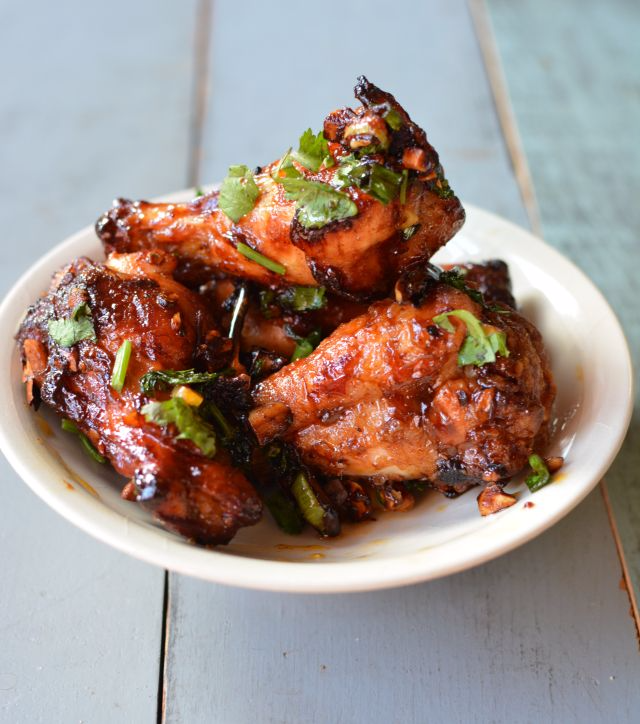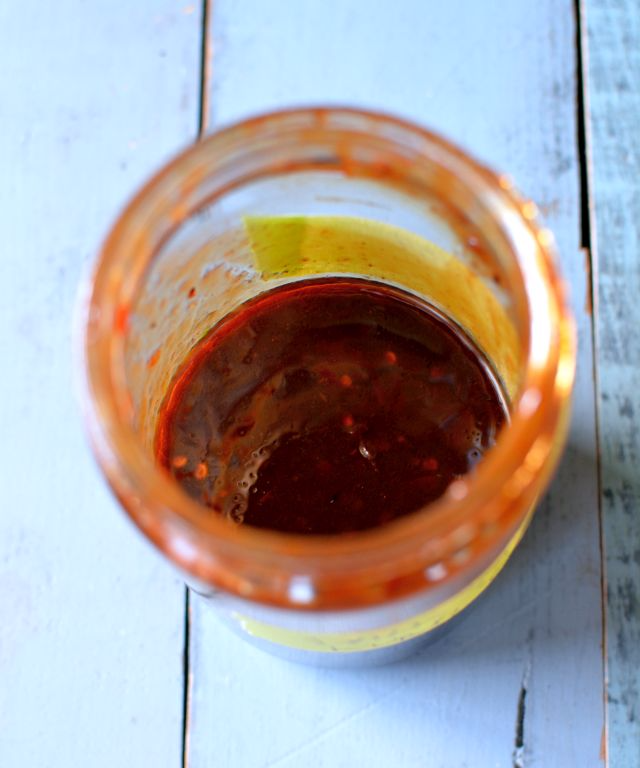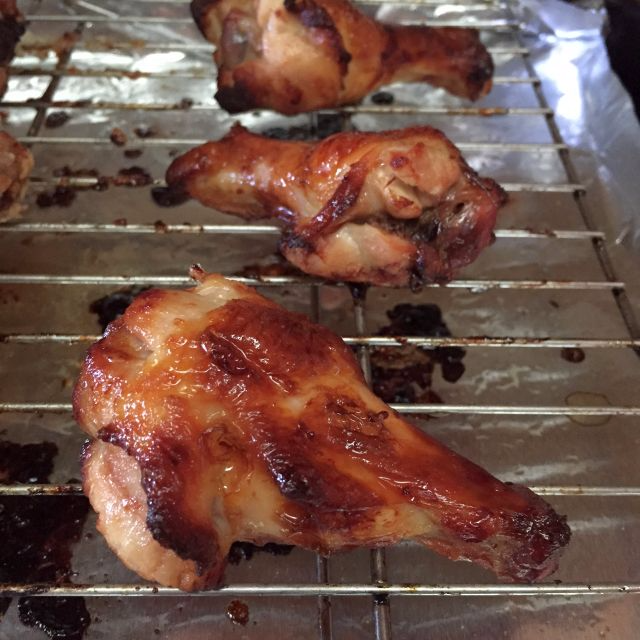
One of the most overlooked part of a cookbook is the section of sauces and seasonings. It’s often placed in the back with few or no photos, in a chapter that’s unceremoniously titled “Sauces” or “Basics”. If you’re a cookbook reader who only goes for recipes with pretty pictures, you’re likely missing out on a treasure trove of secret recipes. I always look at that section of the book because that’s where a cookbook writer or chef stores key and oft-used recipes that they rely upon. It’s not a discard section of the book but rather chock full of ideas and techniques that will help you master the recipes in the book and perhaps use to tweak your regular repertoire.
That’s how I ended up with over 2 cups of Dale Talde’s kung pao sauce in my fridge. Talde is based in New York and highly creative, mixing and matching ideas. He’s Filipino-American but his cookbook, Asian American, mixes traditions. For example,Thai miang kam, usually served on wild betel leaves (la lot) are prepared with Japanese shiso, Korean sesame leaves and Vietnamese tia to (all three are perilla leaves but with different flavors). Char siu pork is served with an apple salad and tahini mustard. I can imagine this kind of food in modern cafes in Asia but it’s happening in Brooklyn, New York. There’s also a nachos recipe.
The book's tone is slightly irreverent but also peppered with humility. The occasional image of Talde with overly endowed women send a message of parody. His outfit always includes an apron to remind you that he's a cook. He often sports a goofy look even as he tries to look tough. In all honesty, I ignored most of the images and paid attention to the text, which is full of verve. Asian American is a fun book that unleashes fresh ideas to consider and tinker with.
The kung pao sauce promised to be multipurpose. I had all the ingredients required for the sauce so it took little time to put together. The recipe was written with some hints, like use Lee Kum Kee brand of chile bean sauce and Mae Ploy brand of Thai sweet chile oi. I have a very assertive chile bean sauce from Sichuan. It’s salty and spicy. My Thai sweet chile sauce is tangy-sweet and not cloying like Mae Ploy’s. I knew that my version would not be exactly what Talde intended but you cannot control what a cook does in the privacy of his/her kitchen. I also had homemade chile oil (I use my recipe in Asian Dumplings). So cookbook reading hint #2: If there’s an ingredient line that says, “X amount of chile sauce, such as Lee Kum Kee” that’s the brand that the writer/chef used. (Chefs rarely write their own books nowadays and Talde smartly collaborated with J.J. Goode to put the book together. J.J. worked on Andy Ricker’s Pok Pok; the Thai-style pork ribs recipe for a taste.)
Talde’s book flaunts the notion that its recipes are proudly inauthentic. In this age of fast-moving ideas, authenticity is best measured by whether or not a person is honest, true, and earnest in his/her endeavor. A traditional kung pao gets a tart, smoky edge from vinegar. Talde’s recipe called for unseasoned rice vinegar, which is pretty mild. I tried it but found myself adding Chinkiang vinegar (a dark lusty vinegar produced in a region near Shanghai) whenever I used it. You can use rice vinegar but I’m switching to the darker, more complex vinegar. It went better with my set of ingredients.
What do you do with all that sauce? I put it on all sorts of things, tossing it onto roasted baby potatoes and roasted cauliflower. I also added it to the end of a fried rice, as well as stirred it into noodles.
The sauce is also employed for Talde’s much lauded kung pao chicken wings, which are quite brilliant with its overnight marinade in yoghurt. I baked the wings instead of frying it as Talde suggests. High heat roasting in the upper third of the oven is how I got a slightly crisp finish on the wings. It came together nicely for a restaurant-style snack that you don’t have to really fuss over. I’m not a ranch dressing fan but you can certainly offer some on the side to cool the fire a tad.
Talde’s recipes may seem unconventional but when you dive into one, you see where he’s going and the end-product is thrillingly fun. I’ve adapted the recipe below from Talde’s Asian American cookbook published by Grand Central. You won't end up with 2 cups of sauce but there will be extra for you to play with.
Baked Kung Pao Chicken Wings
Serves 4 to 6 as a snack
Ingredients
- 2 pounds chicken drumettes and/or flat parts too
- ½ cup (120 ml) yogurt (full fat, not Greek)
- 2 to 3 teaspoons fish sauce
- 1 tablespoon neutral oil, such as canola
Kung Pao Sauce
- 3 tablespoons neutral oil, such as canola
- ¾ teaspoon annatto seeds or ½ teaspoon paprika
- ¾ teaspoons Sichuan peppercorns
- ½ star anise, broken up into individual points
- 1 ½ teaspoons chile oil, homemade or store bought
- 3 to 4 tablespoons chile bean sauce (use less if you have punchy Sichuan dou ban jiang; more if you have milder Lee Kum Kee brand)
- ¼ cup (60 ml) Thai sweet chile sauce, purchased or homemade
- 3 tablespoons oyster sauce
- 2 tablespoons Shaoxing rice wine, dry sherry, or bourbon
- 2 ½ tablespoons Chinkiang vinegar, or 1 ½ tablespoons balsamic and 1 tablespoons cider vinegar
- 1 ½ teaspoons sesame oil
Finish the wings
- 2 tablespoons neutral oil, such as canola
- ½ teaspoon ground Sichuan peppercorn
- 6 dried Asian chiles, snipped in half lengthwise with scissors and seeds discarded
- ¼ cup (60 ml) coarsely chopped unsalted, roasted peanuts
- ½ cup (120 ml) kung pao sauce (above)
- ¼ cup (60 ml) thinly sliced green onion
- ½ cup (120 ml) loosely packed roughly chopped cilantro stems and leaves
- ½ cup Ranch dressing (optional)
Instructions
- In a zip-top bag, combine the chicken, yogurt, fish sauce and oil. Seal and refrigerate overnight or up to 24 hours.
- Meanwhile, make the sauce. In a small saucepan or butter warmer, combine the neutral oil, annatto (or paprika), peppercorns, and star anise. Bring to a gentle sizzle over medium heat. Cook, shaking the pan, until aromatic, about 1 minute. Remove off heat and stir in the chile oil. Combine the remaining sauce ingredients in a bowl. Strain the oil into the bowl; discard the solids. Whisk or stir until you see no separation between the ingredients. Transfer to a jar and refrigerate up to 1 month, or freeze for 3 months. You will have a generous 1 cup (240 ml).
- Remove the chicken from the fridge. Position a rack in the top third of the oven and preheat to 450F (230C). Line a baking sheet with foil or parchment and put a rack on the sheet. Arrange the wings on the rack with 1 to 2 inches of space between them for heat circulation. Bake for about 45 minutes, turning 2 or 3 times to ensure even browning. Cool slightly.
- To finish the wings, use a large skillet or wide Dutch oven. Put the remaining oil, ground peppercorn, and dried chiles in the pan. Heat over medium-high until sizzling and fragrant. Increase the heat to high and add the chicken and peanuts. Stir to coat and fry the peanuts for about 1 minute, until they’re fragrant.
- Add the kung pao sauce, expect lots of sizzling. Stir to combine, then add the green onion and cilantro. Cook for 1 to 2 minutes until the ingredients clings to the wings. Transfer to a platter or small dishes and dive in, with or without the Ranch dressing.


















